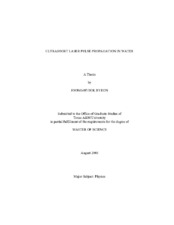| dc.contributor.advisor | Kattawar, George W. | |
| dc.creator | Byeon, Joong-Hyeok | |
| dc.date.accessioned | 2010-01-16T02:29:39Z | |
| dc.date.available | 2010-01-16T02:29:39Z | |
| dc.date.created | 2008-08 | |
| dc.date.issued | 2010-01-16 | |
| dc.identifier.uri | https://hdl.handle.net/1969.1/ETD-TAMU-2008-08-60 | |
| dc.description.abstract | We simulate ultrashort pulse propagation through water by numerical methods, which
is a kind of optical communication research. Ultrashort pulses have been known to have
non Beer-Lambert behavior, whereas continuous waves (CW) obey the Beer-Lambert
law. People have expected that the ultrashort pulse loses less intensity for a given
distance in water than CW which implies that the pulse can travel over longer distances.
In order to understand this characteristic of the pulse, we model numerically its spectral
and temporal evolution as a function of traveling distance through water. We achieve the
pulse intensity attenuation with traveling distance, obtain the temporal envelope of the
pulse and compare them with experimental data. This research proves that the spectral
and temporal profile of a pulse can be predicted knowing only the intensity spectrum of
the input pulse and the refractive index spectrum of water in the linear regime. The real
feasibility and the advantage of using an ultrashort pulse as a communication carrier will
also be discussed. | en |
| dc.format.mimetype | application/pdf | |
| dc.language.iso | en_US | |
| dc.subject | ultrashort pulse propagation simulation water beer-lambert law | en |
| dc.title | ULTRASHORT LASER PULSE PROPAGATION IN WATER | en |
| dc.type | Book | en |
| dc.type | Thesis | en |
| thesis.degree.department | Physics | en |
| thesis.degree.discipline | Physics | en |
| thesis.degree.grantor | Texas A&M University | en |
| thesis.degree.name | Master of Science | en |
| thesis.degree.level | Masters | en |
| dc.contributor.committeeMember | Sokolov, Alexei | |
| dc.contributor.committeeMember | Yang, Ping | |
| dc.type.genre | Electronic Thesis | en |


